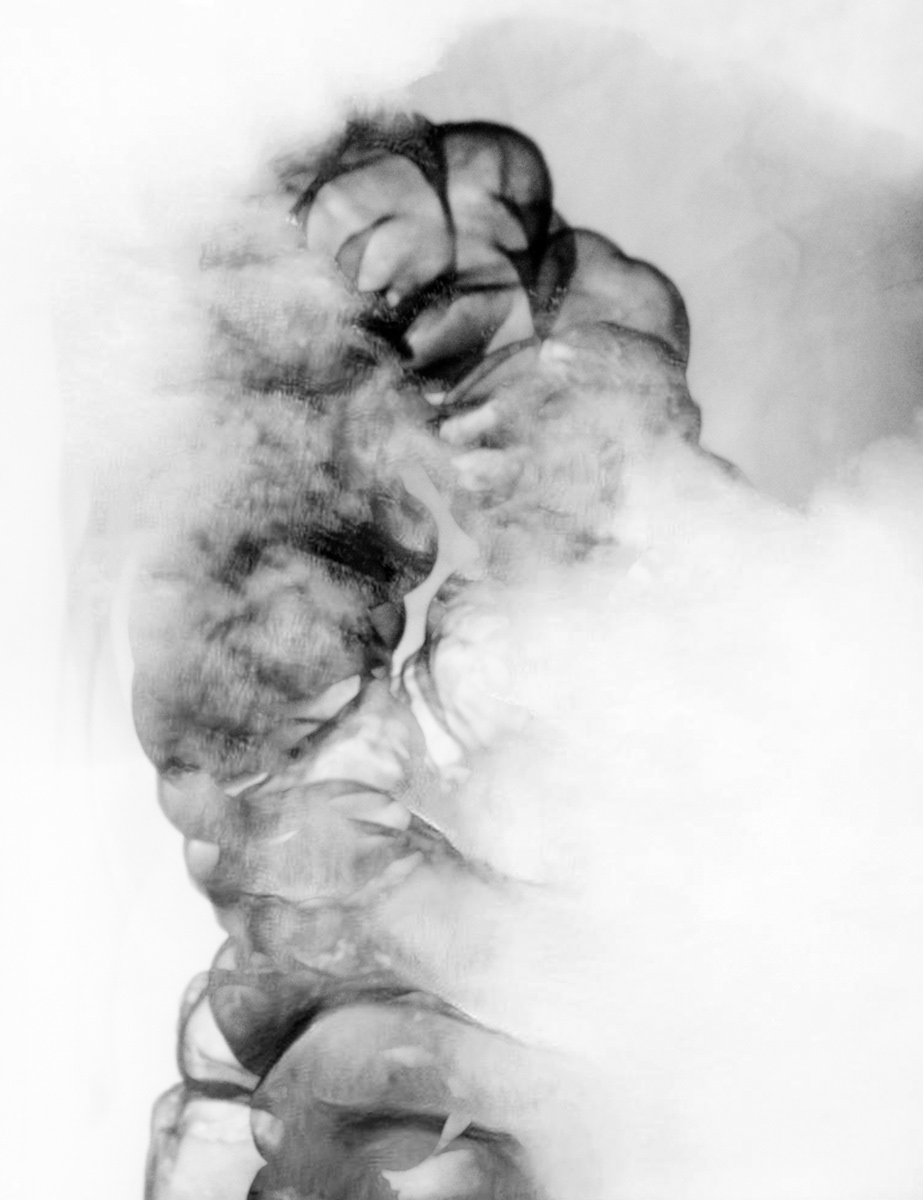14 January - 2 March 2024
Alexander Kadow - Franca Ravet - Mathieu Zurstrassen, The Individual Below
The exhibition The Individual Below brings together Alexander Kadow’s x-ray-based photographs, Franca Ravet’s x-ray-based paintings, and a piece called /ˈlɪmbəʊ/, the animatronic eye developed by Mathieu Zurstrassen.


Alexander Kadow
Left: TiB#002 (2021), silver gelatine print on baryta paper, 65 x 50 cm
Right: TiB#017 (2021), silver gelatine print on baryta paper, 35 x 28 cm
Left: TiB#002 (2021), silver gelatine print on baryta paper, 65 x 50 cm
Right: TiB#017 (2021), silver gelatine print on baryta paper, 35 x 28 cm
In his photo series entitled The Individual Below, Alexander Kadow explores both the relationship of individuals to data sets in which they are embedded as an abstracted form, and the reference to reality of specific photographic techniques. Kadow's compositions combine images generated by a specially developed algorithm, trained with hundreds of x-ray images. The resulting pictures raise the question as to what is or is not a faithful representation of reality, at a level where analogue and digital technologies meet.


Franca Ravet
Left: Identités croisées (2023), painting, 60 x 60 cm
Right: Cortex-papier (2011), painting, 40 x 40 cm
Left: Identités croisées (2023), painting, 60 x 60 cm
Right: Cortex-papier (2011), painting, 40 x 40 cm
Similar questions may arise as regards the paintings by Franca Ravet, who uses medical imaging of a scull as a starting point for her pictorial explorations. These may involve handwritten reflections, write-overs or other pictorial elements, leading in some cases to an almost complete obliteration of the initial image. With these newly created artworks, Ravet seeks to examine the role of the individual in a different context, which may be historical or political.
Mathieu Zurstrassen
/ˈlɪmbəʊ/ (2023), mixed media, 69 x 21 x 16 cm
/ˈlɪmbəʊ/ (2023), mixed media, 69 x 21 x 16 cm
As to Mathieu Zurstrassen's animatronic eye, while our visual focus is directed at the art works displayed, /ˈlɪmbəʊ/ looks out, thus reversing the perspective.
About the artists:
Alexander Kadow was born in 1985 in Winsen/Luhe, Germany. He lives and works in Hamburg and Berlin. Kadow obtained both his Bachelor’s and Master’s degrees in Fine Arts at the Hochschule für Bildende Künste Hamburg. He also participated in the photography master class at the Ostkreuzschule für Fotografie, Berlin.
Kadow’s works deal with materials that have a connection to photography and thus to the representation, preservation and interpretation of what we call reality. By repurposing technical image products and their tools - from light-sensitive materials to scanners and AI algorithms - he creates images that move between abstraction and representational forms. Kadow was one of the laureates of the 'gute aussichten - junge deutsche fotografie 2021/22' award, and a 'FUTURES Photography Talent, 2019' fellow.
Since 2015, Kadow has participated in numerous group and solo exhibitions in Germany, The Netherlands, France and Italy.
Kadow’s works deal with materials that have a connection to photography and thus to the representation, preservation and interpretation of what we call reality. By repurposing technical image products and their tools - from light-sensitive materials to scanners and AI algorithms - he creates images that move between abstraction and representational forms. Kadow was one of the laureates of the 'gute aussichten - junge deutsche fotografie 2021/22' award, and a 'FUTURES Photography Talent, 2019' fellow.
Since 2015, Kadow has participated in numerous group and solo exhibitions in Germany, The Netherlands, France and Italy.
Franca Ravet was born in Arlon, Belgium. She lives and works in Brussels and in Ribeira de Santarem (Portugal). She graduated from St Luc, Liège and took painting lessons in the atelier of Raymond Julin. She obtained several prizes, including : Médaille d'or, Concours des trois arts à Bouillon; Prix du public, parcours d'artistes St-Gilles, 2000, 2002, 2004; 1er Prix du jury, 'Salon des artistes de l'an 2000'.
She was a member of the Jury d'Arts plastiques 'Prix Hamesse', 2004-2016, chairwoman of the Jury 'Prix Hamesse' 2009, member of the Jury 'Académie des Beaux-Arts de Watermael-Boitsfort, dessin/peinture', 2007-2012.
Since 2000, Franca Ravet has participated in many group and solo exhibitions in Belgium and abroad. Her works are in many private and public collections.
She was a member of the Jury d'Arts plastiques 'Prix Hamesse', 2004-2016, chairwoman of the Jury 'Prix Hamesse' 2009, member of the Jury 'Académie des Beaux-Arts de Watermael-Boitsfort, dessin/peinture', 2007-2012.
Since 2000, Franca Ravet has participated in many group and solo exhibitions in Belgium and abroad. Her works are in many private and public collections.
Mathieu Zurstrassen trained as an architect. From 2013, he embraced the path of visual arts. In designing objects, he moves away from the projection of the drawing and focuses on the experimentation of construction. He uses the codes of craftsmanship to solve aesthetical issues. Highly 'technical', Mathieu Zurstrassen combines the ambiguity of materials, a poetic thought made of humour and delicacy.
Zurstrassen's work has been exhibited in the framework of various events, galleries and festivals such as the KIKK Festival, Ars Electronica or the Venice Biennale.
Zurstrassen's work has been exhibited in the framework of various events, galleries and festivals such as the KIKK Festival, Ars Electronica or the Venice Biennale.